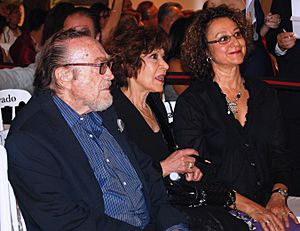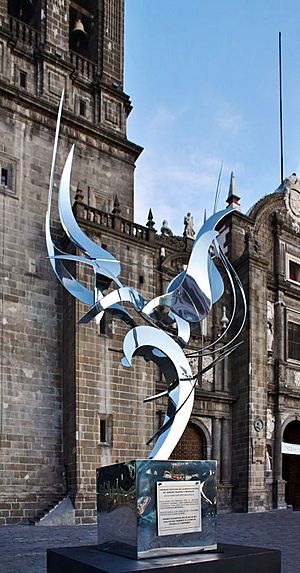Leonardo Nierman facts for kids

Leonardo Nierman (born November 1, 1932 – died June 7, 2023) was a famous Mexican artist. He was best known for his amazing paintings and sculptures. When he was young, he dreamed of being a violinist. He played for twenty years! But he decided to stop after hearing a recording of himself compared to the famous violinist Yehudi Menuhin. Even so, his musical training greatly influenced his art. He saw music and art as very similar, both full of movement and harmony. Nierman's art is abstract, meaning it doesn't show things exactly as they look. But you can still often see shapes from nature, like birds, water, or lightning. His paintings use bright, pure colors. His sculptures are usually made of metal, often shiny silver. He had many art shows in Mexico and around the world. He also received over sixty awards for his work.
Contents
Life Story

Leonardo Nierman Mendelejis was born in Mexico City on November 1, 1932. He was the only child of parents who came from Lithuania and Ukraine. His mother, Clara Mendelejis, worked in a bakery. His father, Chanel Nierman, was a bus inspector who later started a small jacket factory. His parents were poor when they arrived in Mexico in the mid-1920s. They met each other in Mexico.
When Leonardo was a child, he really wanted to be a musician. He spent two decades playing the violin. At that time, art didn't really interest him. He remembered seeing the famous murals by Diego Rivera and José Clemente Orozco. But he didn't feel much, except anger when he saw someone damage an Orozco mural. To follow his music dream, he took private violin lessons. He also went to the National Conservatory of Music of Mexico. He even performed some concerts at the Palacio de Bellas Artes. He stopped playing the violin when he heard a recording of himself. He was playing a piece called Symphonie espagnole by Édouard Lalo. Then he compared his playing to Yehudi Menuhin's, and he felt his own playing wasn't as good.
At first, he thought he had wasted his time with the violin. But later, he realized music had taught him a lot about life. It also prepared him for his painting and sculpture. After leaving music, he started to love colors. He still loved music, especially composers like Bach, Debussy, Mahler, and Stravinsky. But he wasn't sure about painting yet. One day, he was walking in the historic center of Mexico City. He saw an art supply shop and thought about painting as a hobby. But he worried he wasn't prepared enough.
Even though he loved art, Nierman didn't study it formally. He finished high school in 1951, focusing on physics and math. In 1953, he studied how colors and shapes work in moving and still objects. He also spent a lot of time visiting museums. He earned a degree in business from the Universidad Nacional Autónoma de México. But he never worked in business because he had started painting. He even painted a mural at his school. He began painting on his own in his bedroom at his parents' house. He never thought he would become a professional artist. But slowly, painting took up more and more of his time. He became a self-taught artist.
Art Career
Leonardo Nierman began his art career by painting a mural. He convinced the dean of the business school, where he was a student, to let him paint it. This was in 1956. To paint the mural, he met with the famous artist David Alfaro Siqueiros. He asked Siqueiros for advice, especially about mixing colors. Sadly, this mural was later destroyed when the wall was taken down.
Nierman had been painting for a while when Raquel Tibol, an art critic, invited him to show his work. This was at the Centro de Deportes Israeli in Mexico City. He told himself that if he didn't sell any paintings, he would quit art. But two paintings were bought! The owner of the IFA Gallery in Washington, DC saw them. Since 1959, this gallery showed Nierman's art. This helped him become known internationally.
Since then, he had over 100 art shows. These were in North and South America, Asia, Australia, and Europe. Some recent shows include the International Museum of Art & Science in Mcallen, Texas in 2009. He also had shows at the MACAY museum in Mérida in 2012. His art was also shown at the Francisco Cossío Museum in San Luis Potosí in 2012.
You can find his artwork in museums and public buildings all over the world. These include places in Australia, Austria, Colombia, and the United States. His art is also in Spain, Israel, Japan, Mexico, and Sweden. Some famous places include the gallery at the Vatican. His work is also at the Art Institute of Chicago and the Museum of Fine Arts in Boston. The Museo de Arte Moderno in Mexico City also has his art.
His large sculptures and murals are in many major cities. In 1969, he painted a mural for the physics department at Princeton University. He also designed stained glass windows for a temple in Mexico. His metal sculptures are in universities, concert halls, and parks. You can see them in countries like Canada, the United States, and Ecuador. One famous sculpture is the Flame of the Millennium in Chicago. Another is Eternal Light at the University of Illinois Medical Center.
In 1997, he designed a special postage stamp for the Mexican postal service.
He received over sixty awards for his art. About half of these awards were from outside Mexico. Some awards include an Honorific Mention from UNAM in 1960. He became a lifetime member of the Royal Society of the Arts in London in 1965. He also won the Royce Medal in New York in 1970. In 1995, he received an honorary doctorate from Concordia University. The city of Chicago even named December 19th in his honor in 2002. In 2010, he received the Vasco de Quiroga Medal from Mexico City. In 2011, UNAM named a classroom after him.
Artistic Style
Leonardo Nierman created many types of art. He made paintings, tapestry designs, sculptures, murals, and glass art. His first artworks were made in the 1950s. They were influenced by artists like Kandinsky, Klee, Miró, and Chirico. He was also inspired by abstract, cubist, and surrealist art styles. But much of his later work was shaped by how he saw nature. He also looked for connections between abstract art and the universe. This came from his studies of color and movement in the 1950s.
His musical background was another huge influence. He said that music and painting are very similar. Both have different tones, rhythms, and areas of high energy or calm. Some people called him the Jackson Pollock of Latin American art.
His art style is called "magical expressionism." He painted abstract shapes with lots of movement and rhythm. He used very bright colors. His art doesn't tell a story. He described his work as colors interacting to create a special moment. Even though his art is abstract, you can still see parts of nature in it. He often included elements like wind, water, lightning, fire, and volcanoes.
When he painted, he liked to use pure, clean colors. He felt that mixing colors could make the light look dull. He said that when he painted, it was like going a little crazy. He didn't know if the painting was good or not at the time. He only knew it made him feel something. His painting wasn't planned or done on purpose. Nierman once said: "Painting is to me the opening through which it is possible to enter a certain world; in it the viewer may find an endless number of magic images, objects, memories, feelings, fears, joys, hopes and dreams."
His sculptures were made from materials like marble, silver, gold, bronze, and stainless steel. But they were usually silver-colored. These sculptures often included shapes like birds, angels, or musical instruments. His metal sculptures often show movement and harmony. He usually created this feeling by using spirals.
See also
 In Spanish: Leonardo Nierman para niños
In Spanish: Leonardo Nierman para niños

